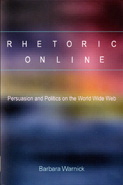The World Wide Web is a space where the many wonderful—and hideous—potentials inherent in human persuasion are performed daily. While the pervasiveness of mediated communication has led many to sing dirges that could be entitled "Democratic Public Sphere: Rest in Peace," Warnick seeks to take seriously the possibilities that the Web offers for public discourse, including affordability, access to mass audiences, transformation of hierarchies such as authority and authorship, and interactivity. As Warnick puts it, "critics should not look to the communication platform or its features as per se good or bad when making attributions about how its use affects society. Instead, they should consider how the Web’s affordances are shaped and applied by users to address social problems" before judging the Web’s effect on public discourse (22).
Following the work of scholars such as James Carey and Susan Herring, Warnick argues that the Web represents a shift or qualitative difference from older forms of media such as print or broadcast television. Among the features of this shift are changes in reading practices brought about by the shorter lexia and intertextuality of hypertext, a rise in the relative persuasive force of images as compared to text, and multimodal persuasion.
Though readers of Kairos will not be surprised by a claim that the Web is qualitatively different from older media, Warnick uses the claim as an occasion to call for scholars in rhetoric to adapt their theories and methods to more fully account for the implications of that claim. Toward that end, Warnick calls for more case studies of online political mobilization and more "rhetorical criticism of positive instances of the use of new media technologies," an area of criticism that she characterizes as "noticeably under-researched," particularly by those in her home discipline of Communication (19).
Warnick offers several possible reasons why rhetorical critics have not yet examined Web-based persuasion and political action fully. First, Web-based persuasion often does not fit the paradigm of political rhetoric as "sustained speech and oratory" and thus makes a poor match with the types of artifacts that many critics are trained to analyze. Second, the digital divide that starkly separated the haves and have-nots in the early days of the Web may have led some to consider the Web as dominated by elites and therefore less fruitful to study than it might otherwise have been.1 Third, 1990s-era utopianism about the Web's transformative power may well have met with a backlash of academic skepticism. Finally, Web-based rhetorical artifacts are ephemeral and, even when they are captured for analysis, features such as animation, images, and links may not appear or behave as they would on a live page.
Nevertheless, because the Web has provided a robust and effective means for shaping political discourse, Warnick would have scholars take the Web seriously on its own terms, adapt their theories and methods, and rise to the challenges of refiguring what counts as a "text" worthy of preservation and analysis. Though these are big challenges, Warnick offers a way into them through media-specific analyses, an approach that forms the basis of Chapter 2.
1 A digital divide still exists, even with the present explosion in the developed world of ever-cheaper basic computer hardware, robust open-source software, and easy means of authoring Web content. As Nielsen (2006) argues, the old digital divide segregated Web users on the basis of affordability; by contrast, the new divide segregates users on the bases of accessibility and empowerment (n.p.). Even though much of the population can get onto the Web, seniors and individuals with low literacy are shut out of much Web content because of its complexity (n.p.). Moreover, many Web users accept search results and default settings on their computers uncritically and also rely on ad-supported Web services (n.p.) Thus, such users in effect allow others to decide how their attention will be directed (n.p.). Of course, in the developing world, where access to food, shelter, security, schooling, and infrastrucuture are poor, the new digital divide is still affected by the old. If anything, the evolving digital divide makes it even more crucial for rhetorical scholars to develop new ways of examining online rhetoric because potential audiences will continue to change as the Web's reach changes.
